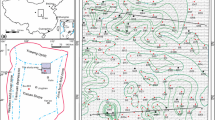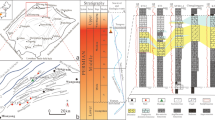Abstract
Thick-block dolomite, including microcrystalline dolomite (Type 1), fine crystalline dolomite (Type 2) and medium crystalline dolomite (Type 3), is extensively developed in the Guanwushan Formation of Devonian in the upper Yangtze region. Petrological, mineralogical and geochemical analyses indicate that the source of dolomitization fluid is contemporaneous seawater. The Type 2 and Type 3 dolomites have resulted from further dolomitization of the Type 1 dolomite. The order degree of the three types of dolomites increased in sequence, and they all show dull cathodoluminescence. The three types of dolomites have higher Sr2+ and lower Mn2+ concentrations than those of limestone. The total amount of rare earth elements of dolomites is lower than that of limestone. However, the dolomites are enriched with LREE and lack of HREE, with a consistent REE distribution pattern of the limestone. The weak negative anomalies of Ce and Eu indicate that the dolomites formed in a weak oxidizing and reducing environment with low temperature, and the dolomitization fluids inherited from the original seawater. The δ18OPDB values of Type 1 and Type 2 dolomites are higher than those of the limestone, indicating that the dolomitization fluid is influenced by seawater evaporation at the penecontemporaneous stage. The δ18OPDB value of Type 3 dolomite is lower than that of limestone, and it also shows anhedral crystal, which indicates that the dolomite has experienced more intense dolomitization stage at greater burial depth and higher temperature.
Access this chapter
Tax calculation will be finalised at checkout
Purchases are for personal use only
Similar content being viewed by others
References
Kenward, P.A.: Ordered low-temperature dolomite mediated by carboxyl-group density of microbial cell walls. AAPG Bull. 97(11), 2113–2125 (2013)
Vasconcelos, C., McKenzie, J.A., Bernasconi, S., et al.: Microbial mediation as a possible mechanism for natural dolomite formation at low temperatures. Nature 377(6546), 220–222 (1995)
Xiong, L., et al.: Origin of dolomite in the Middle Devonian Guanwushan Formation of the western Sichuan basin, Western China. Palaeogeogr. Palaeoclimatol. Palaeoecol. 495(15), 113–126 (April 2018)
Author information
Authors and Affiliations
Corresponding author
Editor information
Editors and Affiliations
Rights and permissions
Copyright information
© 2022 The Author(s), under exclusive license to Springer Nature Switzerland AG
About this paper
Cite this paper
Huang, S. et al. (2022). Dolomitization Fluid and Genesis of Dolomite in the Devonian Guanwushan Formation in Upper Yangtze. In: Çiner, A., et al. Recent Research on Geomorphology, Sedimentology, Marine Geosciences and Geochemistry. CAJG 2019. Advances in Science, Technology & Innovation. Springer, Cham. https://doi.org/10.1007/978-3-030-72547-1_39
Download citation
DOI: https://doi.org/10.1007/978-3-030-72547-1_39
Published:
Publisher Name: Springer, Cham
Print ISBN: 978-3-030-72546-4
Online ISBN: 978-3-030-72547-1
eBook Packages: Earth and Environmental ScienceEarth and Environmental Science (R0)




